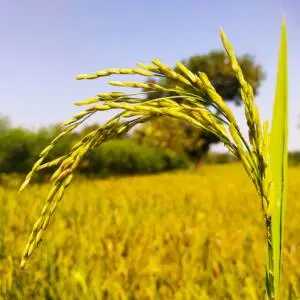No products in the cart.

Paddy Crop The Ultimate Guide to Growing and Harvesting Rice
Paddy Crop The Ultimate Guide to Growing and Harvesting Rice
Introduction
Rice, the staple food for half of the world’s population, is a fascinating crop that has a rich history and deep cultural significance. Growing rice, also known as paddy crop cultivation, is not just a traditional practice but a complex process that involves careful management and understanding of nature’s rhythms. In this comprehensive guide, we’ll explore the journey of rice cultivation from planting to harvesting, and everything in between.

Table of Contents
| Sr# | Headings |
|---|---|
| 1 | What is Paddy Crop? |
| 2 | Origins of Rice Cultivation |
| 3 | Varieties of Rice |
| 4 | Ideal Climate and Soil for Paddy Crop |
| 5 | Preparing the Field |
| 6 | Planting and Germination |
| 7 | Water Management |
| 8 | Fertilization and Nutrient Management |
| 9 | Pest and Disease Control |
| 10 | Growth Stages of the Paddy Crop |
| 11 | Flowering and Pollination |
| 12 | Ripening and Harvesting |
| 13 | Post-Harvest Processing |
| 14 | Benefits of Paddy Crop |
| 15 | Conclusion |
What is Paddy Crop?
Paddy crop, also known as rice cultivation, is the agricultural process of growing rice. It’s one of the most important crops globally, providing sustenance for billions of people.
Origins of Rice Cultivation
Rice cultivation dates back thousands of years, originating in China and spreading across Asia and beyond. Its history is deeply intertwined with human civilization.
Varieties of Rice
Rice comes in several varieties, including long-grain, short-grain, and aromatic. Each variety has its own unique characteristics and uses in culinary traditions.
Ideal Climate and Soil for Paddy Crop
Rice thrives in warm climates with ample sunlight and high humidity. It grows best in flooded fields, known as paddies, and prefers clayey or loamy soil.
Preparing the Field
Before planting, the field must be properly leveled and prepared. This process ensures uniform water distribution and promotes healthy root growth.
Planting and Germination
Rice is typically planted in the spring. Germination occurs within a few days, and the first shoots emerge from the waterlogged soil.
Water Management
Water is crucial for rice cultivation. Fields are flooded to suppress weeds and pests and to provide the right conditions for the rice plants to grow.
Fertilization and Nutrient Management
Rice requires nitrogen, phosphorus, and potassium for optimal growth. Fertilizers are applied at various stages to ensure healthy crop development.
Pest and Disease Control
Rice is susceptible to pests and diseases. Farmers employ various methods, including biological control and pesticides, to protect their crops.
Growth Stages of the Paddy Crop
The growth cycle of rice can be divided into several stages: vegetative, reproductive, and ripening. Each stage requires specific care and management.
Flowering and Pollination
Rice plants produce flowers that are essential for the formation of rice grains. Pollination occurs when the wind carries pollen from one plant to another.
Ripening and Harvesting
Rice grains mature about 4-6 months after planting. Harvesting involves cutting the stalks and collecting the grains, which are then dried and processed.
Post-Harvest Processing
After harvesting, rice undergoes processing to remove the husk and bran layers, resulting in polished white rice ready for consumption.
Benefits of Paddy Crop
Rice is a staple food for over half of the world’s population, providing https://sssorganicstore.com/npk-fertilizer-for-sale-nutrients-plant-growth/essential nutrients such as carbohydrates, proteins, and vitamins. It also plays a crucial role in rural economies and cultural practices.
Conclusion
In conclusion, paddy crop cultivation is not just about growing rice; it’s a way of life for millions of farmers worldwide. Understanding the intricacies of rice cultivation helps us appreciate the journey from farm to table.
FAQs (Frequently Asked Questions)
What is the ideal climate for growing rice? The ideal climate for rice cultivation is warm and humid, with temperatures around 25-35°C (77-95°F).
How long does it take for rice to grow? Rice typically takes about 4-6 months to grow from planting to harvest, depending on the variety and growing conditions.
What are the main pests and diseases affecting rice? Common pests include rice blast and stem borers, while diseases like bacterial blight and sheath blight can affect rice plants.
How is rice harvested? Rice is harvested by cutting the stalks and collecting the grains. The grains are then dried and processed for consumption.
What are the different types of rice? There are several types of rice, including long-grain (like basmati), short-grain (like sushi rice), and aromatic (like jasmine rice).
This article provides a comprehensive overview of paddy crop cultivation, covering everything from the origins of rice cultivation to its growth stages and harvesting methods. Whether you’re a farmer, a food enthusiast, or simply curious about agriculture, understanding the journey of rice from seed to plate is both enlightening and enriching.
Go and turn on towards organic farming to save future and thire save childs:
Elevate Plant Growth with Premium Bone Powder – Buy Now!
Organic Cow Dung Compost: Transform Your Garden Naturally
Premium Humic Acid for Healthy Plants | Enhance Soil & Boost Growth
Boost Plant Growth Naturally with Mustard Cake | Organic Fertilizer
Transform Your Garden with NPK Fertilizer | Boost Growth by 30%
Premium Perlite for Enhanced Gardening | Buy Now
Live Earthworms with Enhance Your Garden (soil health)
1 Neem Khali: Unveiling the Wonders of Nature
1Transform your garden with vermiwash-buy now
1 Premium quality Vermicompost [ केचुआ खाद ]
Follow us:
Tagged Inpaddy crop

